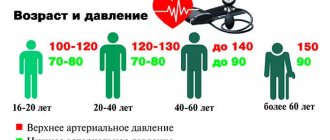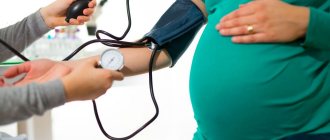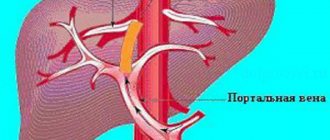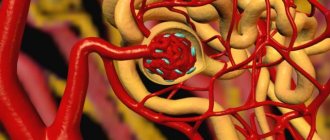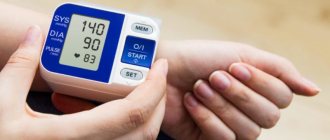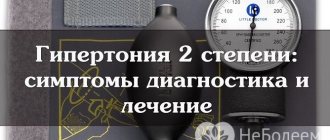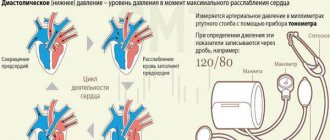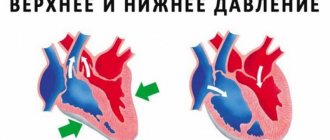What are hypertension and hypotension?
Both diseases cause a jump in blood pressure. With hypertension, the indicators “creep” up; hypotension, on the contrary, is accompanied by low blood pressure. In both cases, the cardiovascular system malfunctions, blood circulation is disrupted and a person’s well-being worsens.
Blood pressure characterizes the functioning of the body's circulatory system. 120/80 is considered the norm and deviations in one direction or another are considered pathology
With both arterial hypertension and hypotension, changes in blood pressure can be temporary. This condition is usually not life-threatening. In the case of consistently high or low indicators, it is worth taking the issue of health more seriously and consulting a doctor.
How does a hypotensive person become hypertensive?
A person suffering from persistent low blood pressure and not paying due attention to the treatment of the disease will eventually encounter increased readings on the tonometer. Hypotonic people become hypertensive under the influence of a number of factors. Age-related changes that occur in the body directly affect the state of the circulatory system. The walls of blood vessels lose their tone, which leads to an increase in blood pressure.
Women experience hormonal changes during menopause. Previously, thanks to estrogen, there was an expansion of the lumens in the bloodstream. However, during menopause, the hormone is absent from a woman’s body, which leads to vasoconstriction and increased blood pressure. During this period, hypertension is often diagnosed, even if there was previously a tendency to hypotension.
The human body is a complex mechanism in which various processes occur. Blood pressure is one of the most important indicators of health. People often suffer from high or low readings. But it also happens that a hypertensive person can become hypotensive and vice versa. This condition is accompanied by serious consequences, since a person cannot always determine the changes on his own. If unusual symptoms develop, it is recommended to seek help from a specialist.
Causes of high blood pressure
Hypertension is a persistent increase in blood pressure. Each person has their own individual blood pressure readings, but assume that the normal figures are 12080 mmHg. An increase or decrease in these limits is regarded as pathology.
A person's blood pressure is determined by two numbers. The first is systolic pressure, that is, the force with which the heart pushes blood into the arteries. The second number indicates the blood tension in the vessels at the moment when the heart is “resting”.
Pressure limits can change during the day. This is affected by:
- Body temperature;
- physical exercise;
- emotional condition;
- drinking alcohol;
- drinking coffee;
- smoking.
If at the same time the indicators return to normal on their own, and the person does not feel discomfort and his condition does not worsen, then this is not hypertension and there is no reason to worry.
The disease is considered to be a persistent increase in pressure above 14090 mmHg. It does not decrease on its own; you need to resort to taking medications with antihypertensive effects. People who have crossed the 40-year mark are predisposed to developing the disease. But the disease also occurs in young people and adolescents.
Hypertension has 3 stages of development, each of which is characterized by an increase in systolic and diastolic pressure relative to the previous phase. Increasing values to 14090 mm Hg. Art. is not yet considered hypertension.
- The first or initial stage is diagnosed at numbers of 140-16090-100 mmHg. Art.
- The second is characterized by an increase in blood pressure within the range of 160-180/100-110 mm Hg. Art.
- The third degree is characterized by a pressure of 180-110 mmHg. Art. and higher.
We can talk about the development of one or another stage of the disease if the corresponding parameters are stable and do not appear sporadically. Exceeding normal limits in stages 2 and 3 does not depend on irritating factors, but is observed constantly and is reduced only by antihypertensive drugs.
During these phases of disease development, structural changes in the myocardium and heart rhythm disturbances occur. Therefore, the dosage of the drug correctly selected by the doctor makes it possible to maintain blood pressure within normal limits, improves the patient’s condition, prevents the development of complications, and prolongs his life.
Hypertension is an increase in pressure not only in blood vessels, but also in cavities and organs. “Arterial hypertension” - the term refers to a symptom of hypertension, which is caused by an increase in vascular tone, narrowing of the lumen of the arteries, which leads to an increase in the load on the walls of blood vessels and an increase in pressure.
Hypertension
If we are talking about arterial hypertension, then it is caused by hypertension. In the case of a hypertensive crisis, these concepts denote one condition - critically high blood pressure levels and corresponding symptoms.
But hypertension is also observed in other pathologies:
- disruption of the thyroid gland;
- decreased excretory function of the kidneys;
- heart failure;
- encephalopathy;
- circulatory disorders in the brain.
Pregnant women may be diagnosed with hypertension associated with hormonal changes. Oral contraceptives and nasal drops can provoke a rise in blood pressure. In this case, the increase in indicators is not associated with cardiac dysfunction.
When the thyroid gland is overactive, blood pressure also increases. Hypertension is a symptom here, since the underlying disease is hyperthyroidism. It is this that increases the production of hormones that lead to vascular hypertonicity.
Hypertension and pregnancy
If the patient does not have any diseases of the internal organs that can increase blood pressure, then hypertension is called essential. In this case, it is impossible to say exactly what exactly provokes hypertension.
- bad habits;
- stress;
- smoking;
- increased body weight;
- overwork;
- age-related changes;
- sedentary lifestyle;
- drinking alcohol;
- increased salt intake.
If the increase in blood pressure is caused by one of the listed reasons, then it is worth eliminating the provoking factor, and hypertension will go away without additional treatment. If these reasons are accompanied by another pathology that affects vascular tone, then hypertension is treated with medications that affect the underlying disease.
Hypertension and nutrition
Hypertension is a persistent increase in blood pressure associated with vascular hypertonicity. The main reason for the development of hypertension is spasm of blood vessels, narrowing of their lumen. In this case, the blood flow through the vascular bed is disrupted, which leads to poor nutrition of the internal organs and the brain.
The causes of this condition can be provoking factors and pathological causes. “Jumps” in pressure are observed in persons with:
- unstable emotional state;
- chronic fatigue;
- obesity;
- disruption of the cardiac system;
- kidney dysfunction;
- endocrine diseases.
The tendency to hypertension increases in menopausal women. This is due to hormonal imbalance, a decrease in the production of hormones responsible for relaxing the smooth muscles that make up the walls of blood vessels.
The development of hypertension can be triggered by VSD, which develops according to the hypertensive type. Dystonia occurs due to a malfunction of the autonomic nervous system. In this case, “jumps” in pressure are observed, caused by disruption of the innervation of smooth muscles, which leads to vasospasm and increased pressure.
Often such “jumps” normalize on their own. But there are cases when the pressure rises sharply to 160-200 mm Hg. Art. and just as quickly decreases, causing the patient a feeling of fatigue and decreased performance because the body is under stress.
Complications of hypertension
Advice! If “jumping” pressure appears, you need to go to the doctor, and not wait for the indicators to normalize themselves.
As mentioned above, hypertension is an independent pathology caused by certain reasons and having characteristic symptoms. Hypertension is a sign of hypertension - high blood pressure. This is the main difference between adult hypertension and arterial hypertension.
Increased blood pressure is not always associated with hypertension. The symptom has one peculiarity - it can occur even with normal vascular tone. This is the difference between hypertension and hypertension.
Another factor in which these two concepts may differ is that hypertension is not always a consequence of hypertension; other pathological processes also contribute to its development. Caused by diseases of the internal organs, hypertension does not always require treatment, since it goes away simultaneously with the elimination of the underlying disease.
Hypertension can be distinguished from hypertension by the nature of its development. The disease progresses gradually. The development of hypertension occurs over time, and hypertension can occur suddenly. An example is acute renal failure.
If hypertension is diagnosed, especially grade 2 or 3, the patient must systematically take antihypertensive medications for life, otherwise the disease leads to severe complications. Hypertension does not always require treatment and goes away after treatment of the underlying disease.
Blood pressure tablets
An increase in pressure occurs due to an increase in peripheral vascular resistance. Spasm leads to a decrease in the lumen of blood vessels, which provokes a surge in pressure. If there are no pathological changes in the body that can increase blood pressure, then provoking causes are identified.
- Hereditary factor. If one or both parents suffered from hypertension, the risk of developing the disease in the child increases.
- Physical inactivity. A sedentary lifestyle leads to the development of stagnant processes in the body, disruption of metabolic reactions, and poor nutrition of organs and tissues. Hence the development of osteochondrosis, in which compression of the nerve roots innervating the vessels occurs. This causes hypertonicity of the capillaries. At the same time, sitting in one position for a long time leads to muscle stiffness. They compress the spinal artery, disrupt blood flow in it, and cause a decrease in circulation in the brain.
- Stress. During strong emotional arousal, adrenaline is released. It causes rapid heartbeat and increases vascular tone. The result of this action is increased blood pressure.
DETAILS: Why is a magnesium drip used during pregnancy?
Stress and high blood pressure
- Nutrition. Addiction to fatty, high-calorie foods leads to excess body weight. This causes the need for increased heart contractions and leads to constant stress on the myocardium. Over time, the heart “gets tired” and cannot cope with its function. In addition, excess cholesterol in the blood causes its deposition on the walls of blood vessels. This significantly complicates the unimpeded passage of blood through the vessels, which creates increased blood pressure.
Nutrition and high blood pressure
These pathologies include:
- Kidney dysfunction. When renal blood circulation decreases, hormones (vasopressin, renin) are released, increasing the tone of the vascular wall. The second cause of hypertension is a decrease in the filtering capacity of the kidneys. As a result, fluid retention occurs and the volume of circulating blood increases. As a result, pressure parameters increase.
- Disruption of the endocrine system. With dysfunction of the endocrine glands (pituitary gland, thyroid gland, adrenal glands), the release of hormones (adrenaline, glucocorticoids) into the blood increases, increasing vascular resistance. Excess aldosterone produced by the adrenal glands retains fluid in the blood vessels.
- Neurogenic hypertension develops as a result of increased intracranial pressure. It is caused by head injuries, tumors, abscesses, and inflammatory processes.
- Hypertension from taking medications. Some medications can cause high blood pressure. These are NSAIDs, contraceptives, medications containing estrogen, and glucocorticosteroids. Hypertension can also be a consequence of drug withdrawal.
Arterial hypertension and hypotension
The term “arterial hypertension” refers to increased blood pressure in the area: the aortic mouth - the arterioles. There are primary and secondary hypertension.
In turn, primary hypertension is divided into two types - hypertension (essential hypertension) and a condition characterized as unstable regulation of blood pressure. The latter type of disease is characterized by periods of increased pressure (borderline pressure).
Symptomatic (secondary) hypertension accounts for 10% of cases of frequent or chronic increases in diastolic or systolic blood pressure. Their development is directly related to damage to systems or organs that directly or indirectly affect the level of pressure.
Increased blood pressure is a characteristic symptom of a disease of these systems or organs. If the leading pathogenetic or etiological factors are eliminated, a noticeable decrease or complete normalization of pressure occurs. Secondary hypertension can be neurogenic, hemodynamic, endocrine, renovascular, parenchymal, renal.
Characteristic renal parenchymal arterial hypertension is increased pressure in lupus nephritis, diabetic glomerulosclerosis, renal anomalies, acquired or congenital hydronephrosis, polycystic kidney disease, chronic pyelonephritis and glomerulonephritis. Renovascular hypertension can be congenital (fibromuscular dysplasia of the renal arteries) and acquired (a consequence of nonspecific aortoarteritis, atherosclerotic narrowing of the renal arteries).
Endocrine hypertension is caused by acromegaly, Itsenko-Cushing syndrome and disease, Cohn syndrome (primary aldosteronism), and chromaffin tumors.
Arterial hypertension
Hemodynamic or cardiovascular hypertension is a consequence of hemodynamic changes, mainly due to mechanical factors.
These include systolic hypertension in thyrotoxicosis, Paget's disease, complete AV block, arteriovenous fistulas, patent ducts arteriosus, aortic valve insufficiency, and aortic atherosclerosis.
Systolodiastological hypertension of the hemodynamic type is provoked by coarctation of the aorta.
Neurogenic arterial hypertension occurs with diseases and focal injuries of the spinal cord and brain, as well as with excitation of the vasomotor centers of the medulla oblongata, which can be caused by respiratory acidosis and hypercapnia.
Symptomatic hypertension occurs when tyramine-containing food products (red wine, cheese) are consumed together with a monoamine oxidase inhibitor (red wine, cheese), in case of thallium, lead poisoning, in case of an overdose of ephedrine, catecholamines, prednisoline, in carcinoid syndrome, in patients suffering from polycythemia.
This group also includes late toxicosis of pregnancy and hypertension that occurs in women who take hormonal contraceptives.
The symptoms and methods of treatment for secondary arterial hypertension are similar to those for hypertension, but in some cases etiological treatment is resorted to. This includes refusal of blood pressure-increasing drugs, reconstructive operations on arteriovenous fistulas, aorta, kidney vessels, and removal of pheochromocytomas.
Borderline arterial hypertension is a type of primary hypertension in young to middle-aged individuals. There are pressure fluctuations from normal to borderline values (140/90-159/94 mm Hg), normal values are often replaced by elevated values, normalization is spontaneous.
Characterized by the absence of target organ damage typical for hypertension: changes in the brain, kidneys, and fundus. Increased blood pressure of the borderline type occurs in 20-25% of the adult population of the planet; under the age of 50, it is more common in men.
For 20-25% of those suffering from borderline hypertension, the disease passes into the hypertensive stage; in 30%, characteristic fluctuations in blood pressure persist for many years; in the rest, the pressure gradually normalizes.
Hypotension is diagnosed when systolic blood pressure falls below 100 mmHg. Art., and diastolic - below 60 mm Hg. Art. Hypotension can be primary or secondary. Primary (essential) hypotension is characterized by two options.
The first (physiological hypotension), when the disease manifests itself in the form of a constitutional-hereditary regulation of vascular tone and blood pressure, which does not leave physiological limits.
The second option (neurocirculatory asthenia) - hypotension acquires signs of a chronic disease with typical symptoms: increased baro- and thermosensitivity, a tendency to fainting and orthostatic reactions, lethargy, drowsiness, headache, increased fatigue, dizziness, weakness.
Secondary arterial hypotension is observed as a concomitant factor in the action of certain drugs, in liver cirrhosis, chronic and acute hepatitis, hypoglycemia, anemia, myxedema, peptic ulcer, Addison's disease, and infectious diseases.
When treating a hypotensive state, it is necessary to eliminate the causes and the main pathogenetic factor of the disease.
Sometimes therapy comes down to physical exercise, drinking strong tea, coffee, adding salt to food, vasopressive and tonic agents are recommended.
Physical treatments
– sedatives (electrosleep therapy, general franklinization, galvanization of the brain and segmental zones, medicinal electrophoresis of sedatives, tranquilizers, antidepressants, local darsonvalization of the head and collar area, iodine-bromine, pine, nitrogen baths, aerophytotherapy of sedatives, round-the-clock aerotherapy);
– hypotensive (transcerebral amplipulse therapy, warm fresh water, sodium chloride, carbon dioxide baths);
– vegetocorrective (transcranial electroanalgesia, galvanization of the brain and ganglia of the sympathetic trunk, medicinal electrophoresis of adrenolytics, ganglion blockers, cholinomimetics; low-frequency magnetic therapy of the head, cervical sympathetic nodes, heart; UHF therapy of the sinocarotid zone, solar plexus, cervical sympathetic nodes; infrared laser therapy, biocontrolled aeroionotherapy );
– RAAS-modulating (galvanization, diadynamic therapy, amplipulse therapy, DMV therapy, low-frequency and high-frequency magnetic therapy of the kidney area)
Spa treatment
Sent to seaside resorts (excluding the hot season), with a climate of mountains, plains and forests. Balneotherapy resorts with radon, carbon dioxide and iodine-bromine waters are shown. In case of stage II hypertension, it is preferable to refer for sanatorium treatment to local cardiological resorts.
Source: //physiotherapy.ru/ill/hipertenzia.html
Causes of pathologies
Both pathologies can arise due to genetic predisposition, excessive physical exertion, past infectious diseases and pathologies of various organs, in particular the heart and blood vessels.
Disruption of the cardiovascular system entails changes in blood pressure.
Also, the development is often caused by poor nutrition, abuse of bad habits, etc. There are a lot of identical reasons, but there are also those that are characteristic of a particular disease:
- Hypotension. It can occur due to pathologies of the adrenal glands, excessive consumption of salt and fatty foods and coffee abuse.
- Hypertension. It often results from blood loss, anemia, increased body temperature and vegetative-vascular dystonia.
Pathologies can also arise due to a sedentary lifestyle, dysfunction of the endocrine system, lack of sleep and frequent psycho-emotional overload.
Note. Diseases can result from problems with body weight. Hypotension often occurs against the background of dystrophy, and hypertension, on the contrary, is due to extra pounds. That is why it is important to control your weight in order to prevent the development of pathologies.
- coarctation of the aorta;
- atherosclerotic lesion of the aorta;
- aortic valve insufficiency.
These disorders lead to difficulty in moving blood through the aorta, the main blood vessel. In addition, heart pathologies can cause hypertension: arrhythmia, heart failure, atherosclerosis of the coronary vessels.
Hypertension is determined by measuring blood pressure. If an increase in numbers is observed after several measurements, then the fact of increased pressure is established. Further diagnostics include procedures to determine the causes of hypertension, as well as concomitant diseases that may result from it.
- The doctor collects a family history and determines whether there are any relatives suffering from heart disease. He finds out the patient’s lifestyle, diet, daily routine. Listens to complaints that can reveal a secondary disease.
- Ultrasound of the heart - shows the shape, volume and contractile function of the organ.
- ECG - determines the rhythm and sounds of heart contractions, can detect ischemic heart damage.
- Daily monitoring (according to indications).
- Doppler ultrasound examination shows the condition and patency of blood vessels.
- Analysis of urine. Using this study, kidney function and excretory capacity are checked, and the clearance of creatinine, uric acid and protein in the urine is recorded.
- Ultrasound of the kidneys and adrenal glands.
- Arteriography – determines the condition of the arteries.
- Consultation with an ophthalmologist (fundus examination).
- MRI of the brain.
Based on the test results, hypertension is treated. If it is not caused by secondary pathologies, then lifestyle correction and elimination of provoking factors bring the pressure back to normal. If there is an underlying disease causing hypertension, it is treated.
According to the prevalence of the process, it can be:
- segmental (with increased pressure only in the splenic vein);
- total (if there is a disturbance in the entire vascular system of the liver).
By localization of the blocking cause:
- posthepatic;
- prehepatic;
- intrahepatic;
- mixed.
With the flow:
- initial, with minor functional impairments;
- moderate (compensated);
- decompensated with pronounced manifestations;
- complicated (development of bleeding and liver failure).
The reasons for the development of this type of hypertension may be:
- Helminthic infestation (echinococcosis).
- Cicatricial narrowings in the biliary tract.
- Inflammation of the pancreas.
- Congenital anomalies in the structure of the biliary tract.
- Benign neoplasms in the area of the head of the pancreas.
- Presence of stones.
- Cancer tumor.
- Metastases in the liver.
- How does it manifest itself?
Symptoms of increased pressure in this case do not appear for a long time. Only the development of general weakness, slight pain in the epigastric region and right hypochondrium is possible.
Symptoms of hypotension
Blood pressure is a measured value; it can be determined using a tonometer. If the device shows values of 90 mmHg systolic (so-called upper) and 60 mmHg diastolic (lower) pressure or lower, then this condition can be called arterial hypotension or low blood pressure.
In addition to the tonometer readings, there are the following symptoms of hypotension:
- General weakness, lethargy, drowsiness;
- Increased sweating and thermoregulation disorders (cold extremities);
- Rapid pulse;
- Sleep disorders;
- Irritability, emotional instability;
- Meteosensitivity;
- Headache (mainly dull in the frontal and temporal regions) and dizziness;
- Dyspnea.
Arterial hypotension very often manifests itself as fainting, especially in stuffy rooms. In general, we can say that people with low blood pressure react negatively to the slightest changes in the external environment - changes in air temperature, humidity, stuffiness, as well as various emotional stimuli.
The listed signs themselves are not symptoms that accurately confirm the presence of hypotension. Isolated cases of weakness or dizziness do not indicate low blood pressure. But if there are several symptoms and they are constant, then you should consult a doctor.
Hypotension can be primary or secondary. Primary occurs as an independent disease. Most often, its cause is low activity of the autonomic nervous system or psycho-emotional stress. Otherwise it is called idiopathic.
Much more common is secondary hypotension, which occurs as a result of other diseases. Hypotension may accompany the following diseases:
- Endocrine disorders, including diabetes mellitus, and most often – disorders of the adrenal glands;
- Injuries to internal organs and especially the brain;
- Osteocondritis of the spine;
- Heart failure;
- Cirrhosis of the liver;
- Hepatitis;
- Peptic ulcer;
- Other.
DETAILS: Blood pressure rises when lying down
It makes no sense to treat secondary low blood pressure without treating the underlying disease, the elimination of which will lead to normalization of blood pressure.
Acute hypotension occurs with severe diagnoses and is characterized by a sharp drop in pressure. Hypotension as a concomitant condition is characteristic of a heart attack, thromboembolism, arrhythmia and cardiac disorders, severe allergic reaction or major blood loss.
Chronic hypotension is also called physiological. It occurs among athletes, but can also occur in people for whom low blood pressure is normal and does not cause negative symptoms.
Low blood pressure is also typical for people who constantly live in unfavorable conditions, for example, among residents of the Far North or the tropics. If low blood pressure is a concern, then such chronic hypotension is pathological and requires correction and treatment.
Arterial hypotension
- Hypotension is a disease characterized by a decrease in blood pressure to the following numbers:
- Systolic – below 90 mm. rt. Art.
Diastolic – below 60 mm. rt. Art.
The cause of clinical manifestations of arterial hypotension is disorders in the blood vessels of the brain. Therefore, it is accompanied by the following symptoms:
- Dizziness
- Headache, which is most often pulsating in the temple area
- General weakness
- Decreased mental and physical performance
- Sleep disturbance, tendency to drowsiness.
Other clinical manifestations may also be observed:
- Palpitations and shortness of breath occur during physical activity
- General emotional instability, which can be expressed in both apathy and irritability
- Feeling lethargic in the morning
- Excessive sweating
- Cold hands and feet as a violation of thermoregulation processes
- Pale skin
- Tendency to fainting.
All these manifestations can occur with arterial hypotension, but the main ones are:
- Reduced pressure when measuring it
- Headaches of a certain nature - pulsating and located in the frontotemporal or frontoparietal areas
- Dizziness and general weakness.
A characteristic feature of people suffering from arterial hypotension is dependence on weather conditions. As a rule, they do not tolerate heat and off-season periods accompanied by low atmospheric pressure.
Also, some patients may experience gastrointestinal disorders - nausea, loss of appetite, feeling of heaviness in the abdomen, flatulence, heartburn.
The following factors may be the immediate causes of arterial hypotension:
- Vegetovascular dystonia is a disease in which hypotension is primary
- Decreased vascular tone, which can be observed with vegetative disorders, allergic reactions and poisoning
- Decreased blood volume – for example due to blood loss or dehydration
- Problems with the heart - failure or defects
- Taking certain medications that lead to low blood pressure.
Speaking about the causes of low blood pressure, several forms should be distinguished:
Physiological hypotension can be:
- Manifestation of the norm in healthy people
- A compensatory reaction of the body in response to certain environmental factors (for example, among residents of high mountains)
- The result of increased training (in athletes).
Primary is most often observed in vegetative-vascular dystonia and the cause in this case is disorders in the functioning of the autonomic nervous system.
Secondary hypotension can occur in certain diseases (for example, anemia, peptic ulcers, and some diseases of the thyroid gland).
To make a correct diagnosis, the following steps must first be performed.
First, you need to measure your blood pressure regularly. This needs to be done systematically and always at different times of the day. In this case, average pressure values will be taken as a basis.
Secondly, it is important for the doctor to collect a medical history, which can provide information about the presence of cardiovascular diseases in relatives and their blood pressure levels.
The necessary examination to diagnose arterial hypotension is an electrocardiogram (ECG). However, no specific changes will be detected on it at reduced pressure. But this study can reveal a certain influence of the sympathetic nervous system on the work of the heart and thereby confirm the functional nature of the change in pressure.
It is also necessary to exclude the presence of secondary hypotension, and for this it is necessary to make sure that there are no diseases that cause it. Such diseases include primarily diseases of the endocrine and cardiovascular systems. Therefore, it is necessary to conduct a full diagnosis, which will additionally include:
- Taking blood and urine tests
- Determination of blood glucose levels
- Study of blood lipid profile with determination of cholesterol levels.
Among the most common complications are:
- Hypotonic crisis, which can develop as a cerebral or cardiac type
- Stroke
- Development of shock with a sharp decrease in pressure.
Treatment in most cases is symptomatic. If secondary hypotension is detected, the underlying disease is treated. It is important to rationally organize working and rest conditions, adhere to the regime, and avoid prolonged exposure to elevated temperatures. You should also stop taking medications that help lower blood pressure.
Health-improving physical education is also of considerable importance, provided it is systematic and the correct selection of the load.
The best way to prevent hypotension is to maintain a healthy lifestyle. This may include:
- Optimal physical activity
Balanced diet
As for nutrition, it should be complete and frequent. It is recommended to slightly increase the amount of table salt. A complete abstinence from alcoholic beverages is also important.
List of diseases Add to favorites
- Headache
| Transesophageal electrocardiography (TEE) |
- Add to Favorites Have you visited this doctor? Rate her work About the rating Make an appointment by phone or Book online
- Add to favorites Mikhailova Ksenia Vladimirovna Have you visited this doctor? Rate her work About the rating Make an appointment by phone or Book online
- Add to favorites Tatyana Kirillovna Pavlova Based on 3 reviews About the rating Make an appointment by phone or Book online
- Add to favorites Marat Anatolyevich Bektaev Based on 5 reviews About the rating Make an appointment by phone or Book online
- Add to favorites Grachev Andrey Vladimirovich Based on 1 review About the rating Make an appointment by phone or Book online
- Add to Favorites Have you visited this doctor? Rate his work About the rating Make an appointment by phone or Book online
- Add to favorites Tikhonov Valery Grigorievich Based on 2 reviews About the rating Make an appointment by phone or Book online
- Add to favorites Zabotnov Vladimir Ivanovich Based on 2 reviews About the rating Make an appointment by phone or Book online
- Add to favorites Gavrish Igor Vyacheslavovich Based on 1 review About the rating Make an appointment by phone or Book online
- 45.97 km.
Pyatnintskoye Highway
Add to favorites Ulyanina Elena Vladimirovna Have you visited this doctor? Rate her work About the rating Make an appointment by phone or Book online
- 45.97 km.
Pyatnintskoye Highway
Add to favorites Korotkova Anastasia Aleksandrovna Have you visited this doctor? Rate her work About the rating Make an appointment by calling “SM-Clinic” in Solnechnogorsk (499) 404-21-95 “SM-Clinic” in Solnechnogorsk, microdistrict. Rekinzo or Book online
Source: //www.medkompas.ru/about-health/diseases/arterialnaya-gipotenziya/
Symptoms of hypertension and hypotension
Both hypotension and hypertension are accompanied by headaches - with low blood pressure, pain is most often localized in the temples and has a shooting character. With elevated levels, as a rule, the head is “heavy”, the pain is pressing and aching, and is grouped in the back of the head and parietal part.
Headache and weakness are signs of both high and low blood pressure. A tonometer will help you accurately determine blood pressure
Also, both conditions entail nausea, general weakness, and heart rhythm disturbances - with hypertension, tachycardia occurs more often, with hypotension, bradycardia. In addition, in both cases, vision and hearing may be impaired, and “spots” often flash before the eyes.
Symptoms of diseases
Hypertensive patients often learn about increased blood pressure from doctors when they are in a serious, possibly pre-infarction, state. The pathology is asymptomatic in most cases, for which it is nicknamed the “silent killer.” Significant manifestations of hypertension are:
High blood pressure causes headaches.
headache;- cardiopalmus;
- chest pain;
- dyspnea;
- dizziness;
- “flies” before the eyes;
- ringing/noise in the ears.
Hypotension, in comparison with hypertension, is mistakenly considered a harmless phenomenon. As a result of a decrease in blood pressure, a hypotensive person experiences oxygen starvation of all internal organs, including the brain, which leads to serious changes in the body. Hypotonic patients complain of symptoms including:
- severe headache;
- weakness, drowsiness;
- irritability;
- fatigue;
- memory impairment.
"Portraits" of diseases
Often hypotensive people become hypertensive, despite the fact that the “portraits” of people suffering from these pathologies are different:
| Hypertensive | Hypotonic |
| An overweight person who prefers rich, high-calorie food. Drinks alcoholic beverages and often smokes. Does not like physical activity. In the morning or after a working day, after stressful situations, due to physical fatigue or a sudden change in weather, his condition worsens. Irritability, weakness, pain in the head and chest appear, darkening of the eyes, and noise in the ears. Because of this, he cannot sleep properly. | Often this is a person of fragile build, with constantly cold hands and feet. Prone to fainting. He often feels nauseous and his vision becomes dark, especially during intense physical activity or in a stuffy room. Suffers from frequent dizziness, throbbing, bursting headaches. A hypotensive person has a poor appetite and often finds it difficult to breathe. |
Diagnostics
So hypertension - what is it, and what is its main difference from hypertension? Hypertension, as noted earlier, is a symptom of hypertension. At the slightest suspicion of elevated blood pressure, it is necessary to monitor its readings twice a day for several weeks.
An automatic tonometer is most convenient for measuring blood pressure at home
If its level is higher than 140/88 mmHg. Art. more than three times in a row when measured at different times, then only in this case can we talk about the presence of hypertension.
The term hypertension is most often used to refer to arterial hypertension. In order to exclude the symptomatic type of the disease, it is necessary to undergo an appropriate examination.
High blood pressure may occur under the following conditions:
- abnormalities in the development of blood vessels, in particular arteries;
- taking medications (glucocorticosteroids, oral contraceptives);
- menopause in women.
Hypertensive and hypotensive - difference in indicators
Almost all experts agree that the indicator 120/80 is quite average. You need to focus on these numbers, but taking into account the individual characteristics of the body of each individual person. Therefore, the term “working pressure” is additionally used, at which good health is maintained.
Hypertensive and hypotensive - difference in indicators
Taking into account all the nuances, and especially the clinical picture, the doctor makes a diagnosis of hypertension or hypotension. But without reference to the values on the tonometer, this cannot be done.
Blood pressure norms for hypertension
In official medicine, a hypertensive person is considered to be a person whose blood pressure level remains above the following levels for a long time:
- 139 mmHg Art. systolic indicator;
- 89 mmHg Art. diastolic.
In addition, the age criterion is important. For a person over 60-65 years of age, such figures are considered quite normal, but for a child and teenager – critical.
The norm is also determined according to the stage of the disease:
- first degree of hypertension – 140-159/90-99;
- the second – 160-179 by 100-109 mm. rt. st;
- third (severe) – more than 180/110.
The normal pressure is determined according to the stage of the disease. These are arbitrary figures. In practice, a person can feel good even with a value of 150/90. But they are necessary to determine the pathology and prescribe adequate treatment.
Normal values for hypotension
Unlike hypertension, hypotension is more easily defined and cannot be classified. The diagnosis is made when permanent readings are 100 to 60 mm Hg. Art. The limit values that negatively affect well-being are determined at the level of 80-90/60.
Low vascular tone leads to a drop in blood pressure of at least 20 mm Hg. Art. relative to the norm and remains this way for a long time. An indicative sign, unlike hypertension, is precisely the condition. If at 100/60 a person feels normal, then they are “working” and have nothing to do with the disease. But this does not mean that you do not need to use a tonometer. It is necessary to measure blood pressure, especially if there is malaise and a predisposition to vascular pathologies.
Treatment
In secondary hypertension, the primary disease must be treated first. Possible therapeutic measures are aimed at relieving symptoms and maintaining or restoring quality of life.
Hypertension therapy is based on the following principles:
- Reduction of individual risk factors;
- Drug therapy (ACE inhibitors, alpha blockers, angiotensin II receptor antagonists, beta blockers, calcium channel blockers, diuretics, renin inhibitors);
- Nutritional and microelement therapy;
- Physical activity;
- Reducing stress.
The difference between hypertension and hypotension is that reduced blood pressure does not require drug therapy in most cases. For hypertension, it is recommended to simultaneously exercise and take medications.
Beta blockers
Classify three stages of hypertension, each of which requires special therapy:
- 1st - diuretics and beta2-blockers (Anaprilin) are prescribed, which help stop tachycardia and lower blood pressure (the dosage is individual, depending on weight).
- To relieve symptoms of the 2nd stage of the disease, beta2-blockers, antispasmodics, and potassium-containing drugs are prescribed for hypokalemia to normalize heart function.
- Stage 3 – the body often reacts with resistance (insensitivity) to the above-mentioned drugs. In this case, therapy is selected individually depending on the clinical characteristics of the body. Be sure to include - diuretics, magnesia, beta-blockers, ACE inhibitors, Ca-channel blockers.
Therapy for hypotension should consist of a set of actions:
- Taking stimulants containing caffeine.
- Natural herbal preparations (valerian, ginseng) that increase vascular tone and blood pressure.
- Aeroionotherapy.
- Massage.
- Aromatherapy.
- Vitamins.
- Saunas, contrast showers.
Getting rid of hypotension is much more difficult than getting rid of hypertension. Pressure changes are felt more acutely; a slight increase in blood pressure is tolerated by the patient as a hypertensive crisis. It is quite difficult to select the necessary therapy; the use of drugs that increase blood pressure in excessive doses can lead to the death of the patient, because weakened blood vessels are simply not able to withstand such loads.
It is worth noting that hypotensive patients, as well as hypertensive patients, are prohibited from drinking alcohol. Many people try to increase their blood pressure by drinking coffee with cognac - they should remember that at these moments they are risking their lives.
It is impossible to get rid of hypotension; you can only try to stabilize the patient's condition. It is necessary to adjust your sleep patterns, correct your diet (you can eat salty and pickled foods), of course, in reasonable quantities. Daily walks in the fresh air, swimming in the pool and light physical activity are beneficial.
For hypertension, medications are prescribed that eliminate excess fluid from the body, thereby relieving the load on the heart muscle. In addition, in case of high blood pressure, medications are prescribed that lower blood pressure levels.
Treatment is prescribed only by an experienced specialist; self-medication can cost you your life.
Therapy for hypotension also involves normalizing the cardiovascular system, but the difference will be that with low blood pressure, drugs with a hypertensive effect are prescribed, that is, to increase blood pressure. In addition to medications, lifestyle adjustments and diet therapy are provided.
Important! Both antihypertensive and hypertensive drugs have a large list of contraindications and, if used incorrectly, can lead to serious consequences. Before starting a course of treatment with one or another remedy, you should consult your doctor.
If you have high blood pressure, you should not eat fatty, fried, salty or spicy foods. Various confectionery products and coffee-containing drinks are also contraindicated. Hypertensive patients are recommended to consume lean meat and fish, lean dishes and juices prepared at home.
Decoctions of hawthorn, rose hips and viburnum help normalize blood pressure. It is better to steam or boil foods; frying in oil is not recommended. This can lead to an increase in cholesterol in the blood, and subsequently a jump in blood pressure.
To maintain health, a person's diet must contain fruits, vegetables and healthy fats. Fast foods are strictly contraindicated
Diet for hypotension
It is better for hypotensive people to give preference to salty dishes, meat, fish, cottage cheese, medium-fat sour cream, and baked goods. If your readings are consistently low, you can drink coffee (in moderation) and eat dark chocolate. This will help increase blood pressure levels by several units without taking additional medications.
It would also be a good idea to drink a cup of strong black tea with the addition of ginseng tincture. In addition, unlike hypertension, in which the volume of fluid consumed must be reduced to the maximum, with hypotension, on the contrary, it is recommended to drink (at least 1.5 liters per day).
Having considered all the features of the diseases, we can conclude that they are both dangerous for humans and require special attention. Any symptom indicating a blood pressure disorder should be a reason to consult a doctor. The sooner the patient sees a specialist, the more favorable the prognosis will be.
To normalize high blood pressure, you need to pay attention to hypertensive symptoms.
DETAILS: Treatment regimens for arterial hypertension ⋆ Heart Treatment
If there is a systematic increase in blood pressure, you should contact a qualified specialist for help.
As a rule, in addition to the basic examination, it is also necessary to determine the level of cholesterol in the blood, find out the levels of potassium and sodium in the body and do an ECG, which will help detect possible contraindications to the use of certain drugs.
It is very important to note that the goal of treatment for this disease is to eliminate the possibility of damage to organs such as the heart, brain and kidneys. They are the ones who primarily suffer from high blood pressure.
At the moment, there are several principles for the treatment of hypertension:
- minimizing salt consumption, the daily dose of which should not be more than four grams per day;
- getting rid of excess body weight;
- daily moderate physical activity (running, walking and physical therapy);
- the use of plant-based sedatives for excessive emotional excitability;
- complete rejection of some bad habits that poison the body.
If high blood pressure is not treated, it will sooner or later lead to a fatal stroke or heart attack.
In order to cure the disease, it is necessary to find out how arterial hypertension differs from hypertension. As you can understand from this article, hypertension is a symptom of hypertension that must be eliminated.
Hypertensive heart disease
Hypertension is a chronic disease that must be diagnosed and treated promptly under medical supervision. Otherwise, dangerous cardiac or vascular complications may develop. Most often, patients learn about the disease when it enters the second stage. The first symptoms of hypertension are similar to ordinary fatigue, and are rarely the reason for visiting a doctor.
Essential hypertension is diagnosed in the presence of hypertension. Almost all (95%) hypertensive patients suffer from it. The remaining 5% have secondary arterial hypertension caused by third-party chronic diseases.
Upper pressure in hypertension rises above 140 mm. rt. Art., lower - over 90 mmHg.
The symptoms of hypertension are as follows:
- Headaches and dizziness, chest pain,
- Cardiopalmus,
- Redness of the skin (face, neck),
- Increased sweating.
Increased blood pressure occurs as a result of:
- Diseases of the kidneys and blood vessels (pyelonephritis),
- Diseases of the endocrine system organs,
- Diabetes mellitus, cardiac asthma, glomerulonephritis,
- Physical inactivity,
- Excess weight
- Constant overvoltage,
- Disturbances in work and sleep patterns,
- Poor nutrition
- Technogenic reasons.
In cases of neurogenic hypertension, the main cause of development is neurosis, emotional exhaustion, fatigue, and night shift work.
What is more dangerous – hypertension or hypotension?
Chronic hypertension in the long term significantly damages blood vessels and is a leading risk factor for atherosclerosis. With constant pressure on the walls of the vessel, irreversible plaques can occur, which pose a threat to the patient’s life.
The internal diameter of the vessels becomes narrower, and the vessel walls become more rigid and porous. Due to the decrease in elasticity, the vessels can no longer narrow or dilate to normal values. Diastolic blood pressure increases.
The result is a vicious circle: as the blood vessels are significantly reduced, the load on the heart also increases. Systolic blood pressure increases, which in turn leads to increased pressure on the blood vessels and heart.
Persistently elevated blood pressure and calcification of the coronary arteries can cause irreversible changes in the heart muscle. The result is so-called angina pectoris. In some cases, patients experience myocardial infarction as the only manifestation of the disease.
If narrowing and calcification of one or more branches of the coronary arteries leads to their complete closure, the dependent region of the heart muscle dies due to lack of blood supply.
Atherosclerosis
When the brain is cut off from its vital blood supply, a stroke occurs. As a second mechanism, rupture of porous blood vessels can lead to cerebral hemorrhage. Depending on how many and which areas of the brain are affected, permanent paralysis, speech impairment, or death may occur.
If the kidneys no longer have a blood supply, they cannot adequately perform their most important function—eliminating metabolic waste. Changes in the blood vessels of the fundus of the eye (retina) can be seen during an ophthalmological examination.
Chronic hypertension can lead to retinal hemorrhages due to rupture of small blood vessels. Arterial narrowing may result in decreased perfusion leading to infarction of the optic nerve and retina. Both conditions lead to complete loss of vision.
Patients are interested in: what could be more dangerous to health, hypertension or hypotension? A persistent decrease in blood pressure, which is asymptomatic, can prolong the patient's life. Hypertension in the long term can reduce the quality of life and its duration.
Both pathologies are equally dangerous, since without correct treatment, both a hypertensive attack and a hypotensive one can occur. If we talk about the consequences, then hypertension can cause:
- Loss of vision (complete or partial);
- Kidney failure;
- Brain disorders;
- Myocardial infarction, stroke and acute heart failure.
The effect of hypertension on various human organs
Hypotension often becomes the “culprit”:
- Gastric and intestinal bleeding;
- Ischemic stroke;
- Loss of sensation in the limbs.
The consequences of both pathologies are quite severe, so it is very difficult to say which disease is more dangerous - hypertension or hypotension.
Hypotension is considered more dangerous in its effect on the cardiovascular system than high blood pressure. Hypotensive people have their own so-called scale of blood pressure norms and deviations from this norm.
In a hypertensive patient, lowering blood pressure will only improve well-being and lead to a healthy feeling of self. And even a slight increase in blood pressure with hypertension will not affect the functioning of the heart and internal organs in the same way as it will in a hypotensive person.
It’s worth saying right away that doctors are quite skeptical about a slight increase in blood pressure. An ambulance does not always respond to a call from a patient who complains of a slight deterioration in health.
Unfortunately, even the hypotensive person himself does not attach importance to his blood pressure and its disturbance. Please note that you need to focus not on the general idea of high blood pressure (140/90 mm Hg.
Hypotension can be fatal! Even a slight increase in blood pressure by 5-10 units provokes a heart attack or stroke. You should call an ambulance if you feel weak, have a severe headache, the urge to vomit, feel nauseous, feel dizzy, or feel close to fainting.
Against the background of these negative symptoms, it is necessary to immediately take medications that lower blood pressure: Losartan, Valsartan, Eprosartan, Micardis. If the medicine does not work and the readings on the tonometer do not decrease, then emergency medical care is necessary.
Few people know that hypotension, in its effect on the body, is many times more dangerous than hypertension. Low blood pressure can become high over the course of your life. The reason is age-related (physiological) and pathological (due to disease) loss of tone and elasticity of blood vessels.
The danger of hypertension
It is important to know!
Vessels become dirty very quickly, especially in older people. To do this, you don’t need to eat burgers or fries all day long. It is enough to eat one sausage or scrambled egg for some amount of cholesterol to be deposited in the blood vessels. Over time, pollution accumulates... Read more »
Many people know that when blood pressure levels are elevated, a hypertensive crisis occurs. During a hypertensive crisis, blood pressure rises to 220/120 mmHg. This condition threatens the patient's life. During a sharp jump in blood pressure on the vessels, the activity of the brain is inhibited, and a huge load is placed on the heart muscle. At the same time, there is a risk of stroke, myocardial infarction, vision loss, and impaired renal function.
After suffering pathological conditions - stroke and heart attack, it is difficult or almost impossible for a person to return to their previous state. Some part of the brain (in a stroke) or heart muscle (in a heart attack) remains damaged, which impairs the functioning of the entire organ. Prevention consists in the fact that the patient will have to constantly monitor his health, take medications that lower blood pressure and always have them on hand. Otherwise, another stroke or heart attack may be the last in your life.
Symptoms
The clinical picture of hypertension in the initial stages may not be clearly expressed. A person may not even be aware of high blood pressure and processes developing in blood vessels for a long time. Early and first signs of hypertension are irritability for no apparent reason and increased fatigue.
Symptoms of hypertension in the early stages: neurotic disorders, weakness, sleep disturbances, noise and ringing in the ears and dizziness, rapid heartbeat.
People note decreased performance and loss of concentration. Shortness of breath appears. Headache with hypertension appears more often in the morning in the temporal and occipital region. It may get worse towards the end of the day and when lying down. They are associated with impaired tone of venules and arterioles. Symptoms of hypertension include pain in the heart area. This is due to increased work of the heart muscle to overcome increasing resistance. As a result, a dissociation occurs between the needs and capabilities of the myocardium, which leads to angina pectoris.
Signs of hypertension in later stages are a veil and flashing “spots” before the eyes, as well as other photopsies. They are explained by spasms of the arterioles of the retina. Malignant hypertension can be accompanied by retinal hemorrhages, which lead to blindness. In rare cases, symptoms of hypertension are manifested by vomiting, swelling of the hands and numbness of the fingers, chills, in the morning - heaviness in the eyelids and puffiness of the face, increased sweating.
Video on the topic
What are hypotension and hypertension, their prevention and methods of treatment:
Hypertension and hypotension are two completely opposite diseases that characterize the presence of problems with blood vessels and the heart. If you have the slightest suspicion of the presence of a particular ailment, you should immediately contact a specialist. When examined by a doctor, you will need to donate blood and urine for analysis, as well as undergo a procedure for measuring blood pressure, taking into account all the rules.
In order to independently control your blood pressure level, you need to measure it in the morning immediately after waking up and in the evening. In no case should you measure your blood pressure immediately after eating or playing sports, as the readings may be unreliable. It is advisable to take measurements twice in the morning and in the evening with an interval of three minutes. The smallest result will be the most correct. Experts recommend keeping a special diary in which the results will be entered. This way you can control your own blood pressure.
